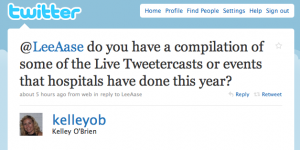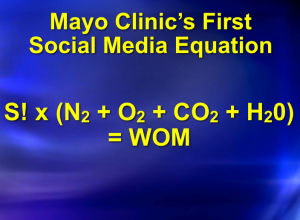Nancy asks:
I’m trying to convince my boss we need to start a twitter account and she’s not convinced. My main argument has been that it would increase our exposure on the web through our links on twitter. Can you help me make a better case?
I saw your slide presentation on slide share on Making the Case for Social Media but it didn’t get to exactly what I need (or I missed it).
And on the slight chance that we do get to start twitter, what can I do to build a following?
Here are my top six reasons why organizations should have a branded Twitter account:
Brand Protection. If you claim your organization’s name on Twitter, others can’t. One headache you don’t want is having someone impersonating your organization on Twitter. Claiming your Twitter handle is a good step, even from a purely defensive perspective.
Scalability. You can have a Twitter account without putting a lot of human resources into it. It’s reasonable at first to use a service that converts the RSS feed of your news releases into tweets, without any additional human involvement. You do have RSS feeds, right? If not, see the Social Media 102 course, and also my third reason.
Serving stakeholders. A non-human Twitter account connected to an RSS feed isn’t ideal, but like RSS it does at least provide a way for people interested in your news to get it in a way that’s convenient for them. And as you become more familiar with Twitter, it can lead to a much better use, Listening and Engagement, which I list as my last reason.
Increased News Coverage. Journalists are increasingly involved in Twitter, and looking to it as a quick way to identify sources and story ideas. Here’s a portion of an email one of my colleagues got in late October from @KimPainter, a columnist with USA Today (click to enlarge):
Kim had seen one of our @MayoClinic tweets connected to our #mayoradio program called Mayo Clinic Medical Edge Weekend. We got her in touch with Dr. Richard Hurt, who was the guest on that program, and here is Kim’s column in USA Today in which he was featured.
It’s Free. Nothing I have mentioned above involves any cash. Your Twitter account is free. Twitterfeed to convert your RSS feed to tweets also is free. But even if you have to manually send tweets about your news, and including a link to your news releases, the time investment can be minimal. It doesn’t involve incremental cash outlays. If you’re like most organizations, you probably pay EurekAlert or PR Newswire or BusinessWire to distribute your news releases. If you are paying for those services, why wouldn’t you take advantage of a free tool like Twitter?
Listening and Engagement. The preceding reasons provide more than enough justification for getting a corporate Twitter account, but engaging stakeholders and listening to them is the best use for Twitter. For that reason, whether your boss approves a corporately branded Twitter account or not, I strongly suggest that you get your own personal Twitter account. Just dive in and start making connections. As you are using Twitter personally, you will see applications that are relevant to your work.
If you have questions about how to get started with Twitter, we have a whole Twitter curriculum here on SMUG to take you through the process. To answer your last question about building a following, see Twitter 103: Following and Being Followed, and Twitter 104: Four Steps to Building Your Personal Twitter Network.


